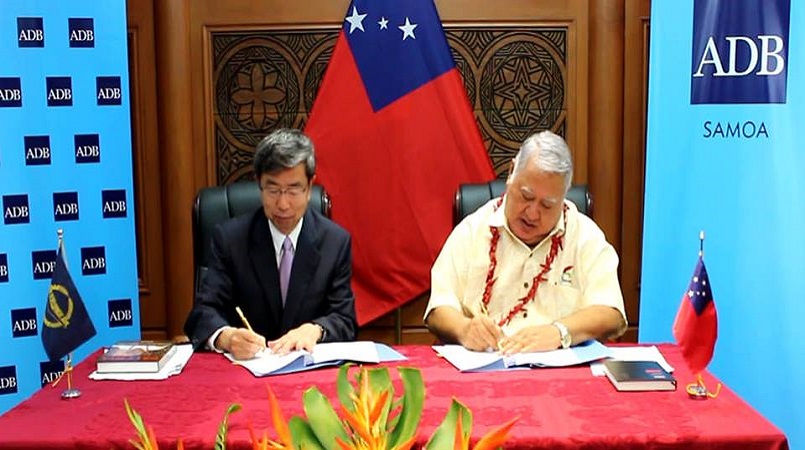
Asian Development Bank (ADB) President Takehiko Nakao and Samoa Prime Minister Tuilaepa Sailele Malielegaoi met Tuesday to examine opportunities for expanded collaboration and sign an agreement establishing a permanent ADB office in Samoa.
President Nakao also met Minister for Finance and ADB Governor Sili Epa Tuioti during his first official visit to Samoa.
“Samoa is a founding member of ADB since 1966 and we have worked in close partnership to address development challenges and create new opportunities in this country,” said Nakao.
“ADB is increasing its support to Samoa and we are committed to helping the government continue to improve access to renewable energy, extend ICT connectivity, and strengthen public sector management.”
“For more than 50 years, we have worked with ADB and together we have made progress in improving water and sanitation, establishing reliable, clean energy and better internet connectivity,” said Prime Minister Tuilaepa Lupesoliai Sailele Malielegaoi.
“ADB has also been a tremendous support in times of disaster as we saw in the wake of the tsunami that devastated parts of the country in 2009. We will continue to work with ADB and our other development partners to help deliver better basic social services to the people of Samoa.”
Economic growth in Samoa slowed to 0.9% in the fiscal year ending 30 June 2018 following the closure of Yazaki Samoa, an automotive parts maker that was the country’s largest private employer. Growth is expected to rebound in the current fiscal year as visitor arrivals increase and infrastructure investment expands in the lead-up to Samoa’s hosting of the Pacific Games in 2019.
“Samoa is well-placed to further expand its tourism industry, which is already a key driver of economic growth and foreign currency earning,” said Nakao. “It will be important to pursue sustainable tourism, which protect the environment, and ensure local communities to benefit.”
ADB has supported development of Samoa’s energy sector since the early 1990s. Projects co-financed with Australia, Japan, New Zealand, and the European Union have installed almost two-thirds of the country’s current generation capacity of 45 megawatts. ADB, Australia, and the World Bank supported the development and operation of a submarine cable fibre-optic system linking Samoa to Fiji. The Tui Samoa cable, launched in February 2018, will provide cost-effective internet connectivity and facilitate e-health investment.
ADB has committed $358 million in loans, grants, and technical assistance to Samoa since 1966 to support the government’s development priorities. Of this funding, $287 million was from the Asian Development Fund (ADF), which provides concessional financing to ADB's lower-income developing member countries. Given Samoa’s vulnerability to the impacts of climate change, ADF financing terms were changed to 100% grant in January 2018.
Future support will continue to focus on economic infrastructure such as power, roads, and ports, as well as public sector management. Total financing from ADF for Samoa, including resources mobilized from ADF funds allocated for regional initiatives could reach $100 million in 2019-2020. In addition, ADB will mobilise co-financing from development partners such as Australia, New Zealand, the Green Climate Fund, and the World Bank.
President Nakao and the Prime Minister signed a host country agreement establishing a permanent ADB country office in Samoa. The office replaces the ADB extended mission in Samoa opened in 2016 to manage the bank’s growing operations in the country.
Nakao is also visiting ADB project sites on Upolu Island including ADB’s first private sector investment in the country, the Solar Power Development Project, which is expanding an existing solar farm to help the country lower its dependence on fossil fuels; and the Fiaga power station and battery storage facility, which are part of the Power Sector Expansion Project that has funded 13 generation projects and 27 transmission projects in the country to meet growing electricity demand.
With Prime Minister Malielegaoi, the ADB President will participate in the commissioning of the Tafitoala and Fausaga small hydropower plant, which is part of the Renewable Energy Development and Power Sector Rehabilitation Project that is adding 3.3 megawatts of new hydropower to the grid and rehabilitating small hydro plants damaged by Cyclone Evan in 2012. He will also visit the Agribusiness Support Project, which is expanding access to finance and providing capacity building support for commercially sustainable agribusinesses.
ADB is building its presence in 11 Pacific island countries to increase the impact of its growing program of assistance. The expansion will involve the conversion of four extended missions—Samoa, Solomon Islands, Tonga, and Vanuatu—into country offices, and the establishment of seven new country offices in the Cook Islands, the Federated States of Micronesia, Kiribati, the Marshall Islands, Nauru, Palau, and Tuvalu. ADB currently has resident missions in Papua New Guinea and Timor-Leste, a Pacific liaison and coordination office in Sydney, and a Pacific subregional office in Fiji.
Across the Pacific region, ADB is significantly scaling up financing to help developing member countries achieve sustainable economic and social development, while strengthening climate and disaster resilience. The volume of ADB active projects in the Pacific has doubled every five years since 2005 and exceeded $3 billion as of end of 2018. The volume of active ADB’s projects in the Pacific is expected to surpass $4 billion by 2020.
Photo supplied
